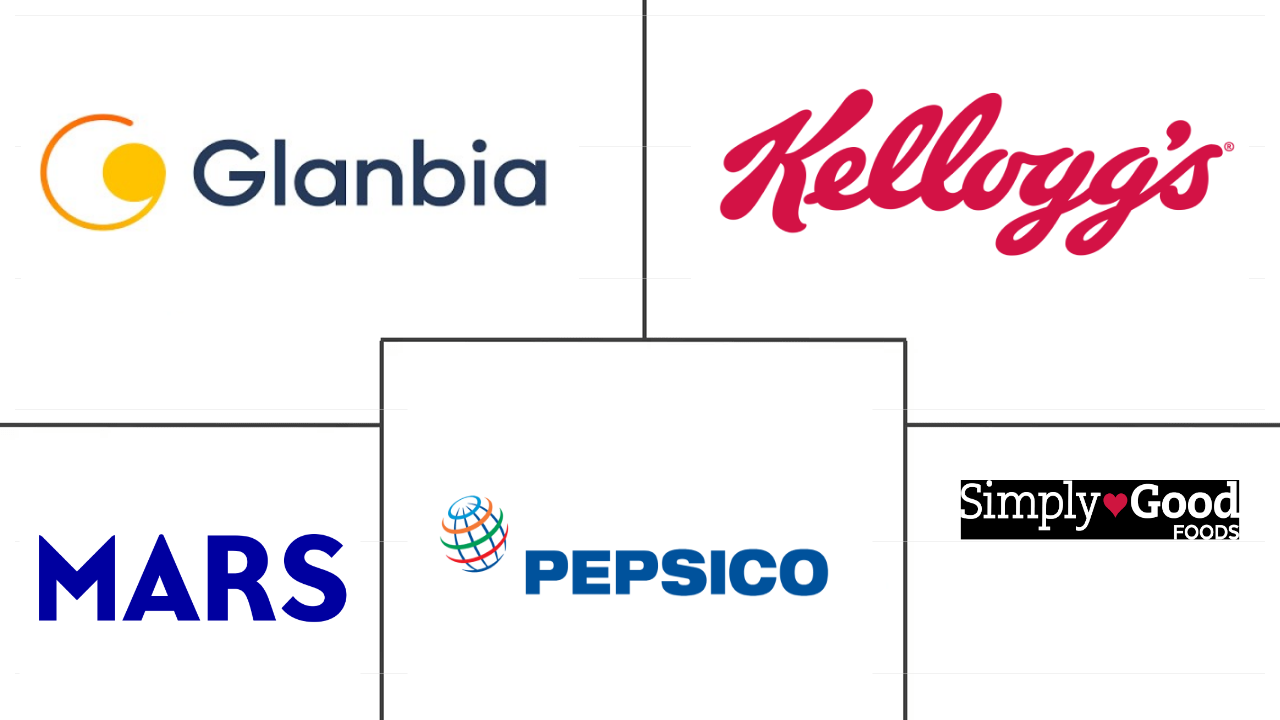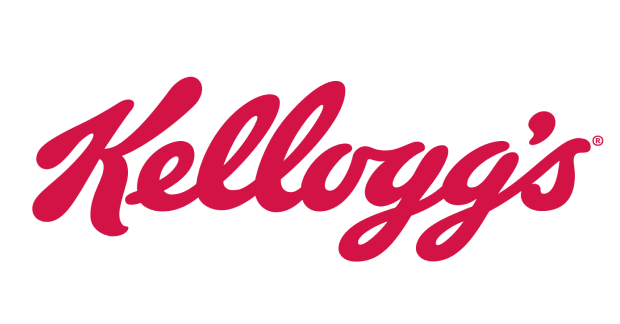Market Size of protein bar Industry
| Icons | Lable | Value |
|---|---|---|
|
|
Study Period | 2018 - 2030 |
|
|
Market Size (2024) | USD 8.91 Billion |
|
|
Market Size (2030) | USD 15.71 Billion |
|
|
Largest Share by Distribution Channel | Supermarket/Hypermarket |
|
|
CAGR (2024 - 2030) | 9.92 % |
|
|
Largest Share by Region | North America |
Major Players |
||

|
||
|
*Disclaimer: Major Players sorted in no particular order |
Protein Bar Market Analysis
The Protein Bar Market size is estimated at 8.91 billion USD in 2024, and is expected to reach 15.71 billion USD by 2030, growing at a CAGR of 9.92% during the forecast period (2024-2030).
8.91 Billion
Market Size in 2024 (USD)
15.71 Billion
Market Size in 2030 (USD)
5.76 %
CAGR (2018-2023)
9.92 %
CAGR (2024-2030)
Largest Segment by Distribution Channel
44.43 %
value share, Supermarket/Hypermarket, 2023
The availability of broad range of products with several brand options in sugar confectionery and ease of free checkout and delivery options are aiding the segmental growth.
Largest Segment by Region
72.48 %
value share, North America, 2023
There has been significant growth in sports and athletics in North America, resulting in a demand for smaller portions of food with high nutritional value in the study period.
Fastest-growing Segment by Distribution Channel
12.18 %
Projected CAGR, Online Retail Store, 2024-2030
The rising preference to buy essential groceries online during the pandemic drove the channel. The growth may be assisted by better consumer reach through digital marketing.
Fastest-growing Segment by Region
13.58 %
Projected CAGR, South America, 2024-2030
The rising health consciousness amid the increasing prevalence of lifestyle diseases has enabled South American consumers to opt for healthy and sustainable snacking options.
Leading Market Player
11.30 %
market share, Kellogg Company, 2022

Product diversity in the sector, making innovative bars with varied protein content for a wide range of consumers, aided Kellogg's to occupy the market share in the market.
Growing e-commerce and preference toward multipacks instead of singles boosting protein bar sales
- Supermarket/hypermarket was observed to be the largest segment by distribution channel in the global protein bar market. The proliferation of the network of multinational brands promotes the growth of the protein bar market. For instance, the Lidl supermarket chain had around 11,200 outlets, Aldi Sud had 7,200 outlets, and Penny Market had 3,600 outlets as of 2022. These retail outlets typically stock a wide variety of protein bar brands, flavors, and types, allowing consumers to choose from a diverse selection to suit their taste and dietary preferences. This helps consumers to stock up on protein bars at a relatively affordable cost. Consumers are increasingly interested in bars with benefits such as energy, weight loss, or sleep support, and they prefer retail stores to buy them.
- The online retail channel is anticipated to be the fastest-growing distribution channel with a CAGR of 0.03% by value over the forecast period, accelerated by the growing global internet penetration, increasing smartphone usage, and expansive network of grocery delivery chains. Online stores allow consumers to select from a large collection of product offerings marketed under private labels as well as mainstream brands. Internet access across key regions is also anticipated to foster online sales of protein bars during the forecast period.
- Convenience stores occupied the second-highest share by value in 2022. The sales of protein bars through convenience stores increased by 7.19% by value in 2022 compared to 2021. Convenience stores are typically located in easily accessible areas, including urban centers, gas stations, and busy intersections. The proximity allows consumers to make quick, on-the-spot purchases of protein bars without having to travel to larger stores.
North America recorded the highest share in 2023, with 50% of gym-goers looking to meet their protein requirements
- North America dominates the global protein bar sales, recording an increase of 8.22% by value in 2022 compared to the previous year. The increasing focus on health and fitness, including interest in weight management, muscle building, and overall well-being, has driven the demand for convenient protein-rich snacks like protein bars. Around 49.9% of Americans go to the gym at least twice a week as of 2022. Protein bars are perceived as a convenient way to increase daily protein intake, making them popular among individuals looking to meet their protein requirements. Protein bars are easy to carry and consume on the go, making them a convenient choice for busy lifestyles.
- South America is the fastest-growing region in the protein bar market and is likely to attain a value growth of 11.65% during the forecast period. Health-oriented products, such as high-fiber, low-calorie, high-protein, and containing natural ingredients, are gaining popularity across the region. As of 2022, Brazil had 539,710 physical education professionals and 65,665 registered companies, including gyms, studios, and sports clubs. The consumer inclination toward fitness is driving the sales of protein bars.
- Asia-Pacific is the second-largest region in the consumption of protein bars globally. The fitness and sports nutrition market is expanding in the region. Athletes and fitness enthusiasts often use protein bars as a convenient source of protein before or after workouts to support muscle recovery and growth. The number of gyms in China increased from 128,900 in 2021 to 142,900 in 2022, indicating the growth of the active population, which is boosting the protein bar market.
Protein Bar Industry Segmentation
Convenience Store, Online Retail Store, Supermarket/Hypermarket, Others are covered as segments by Distribution Channel. Africa, Asia-Pacific, Europe, Middle East, North America, South America are covered as segments by Region.
- Supermarket/hypermarket was observed to be the largest segment by distribution channel in the global protein bar market. The proliferation of the network of multinational brands promotes the growth of the protein bar market. For instance, the Lidl supermarket chain had around 11,200 outlets, Aldi Sud had 7,200 outlets, and Penny Market had 3,600 outlets as of 2022. These retail outlets typically stock a wide variety of protein bar brands, flavors, and types, allowing consumers to choose from a diverse selection to suit their taste and dietary preferences. This helps consumers to stock up on protein bars at a relatively affordable cost. Consumers are increasingly interested in bars with benefits such as energy, weight loss, or sleep support, and they prefer retail stores to buy them.
- The online retail channel is anticipated to be the fastest-growing distribution channel with a CAGR of 0.03% by value over the forecast period, accelerated by the growing global internet penetration, increasing smartphone usage, and expansive network of grocery delivery chains. Online stores allow consumers to select from a large collection of product offerings marketed under private labels as well as mainstream brands. Internet access across key regions is also anticipated to foster online sales of protein bars during the forecast period.
- Convenience stores occupied the second-highest share by value in 2022. The sales of protein bars through convenience stores increased by 7.19% by value in 2022 compared to 2021. Convenience stores are typically located in easily accessible areas, including urban centers, gas stations, and busy intersections. The proximity allows consumers to make quick, on-the-spot purchases of protein bars without having to travel to larger stores.
| Distribution Channel | |
| Convenience Store | |
| Online Retail Store | |
| Supermarket/Hypermarket | |
| Others |
| Region | |||||||||||||||
| |||||||||||||||
| |||||||||||||||
| |||||||||||||||
| |||||||||||||||
| |||||||||||||||
|
Protein Bar Market Size Summary
The protein bar market is experiencing significant growth, driven by increasing consumer demand for convenient and health-oriented snacks. Supermarkets and hypermarkets are the primary distribution channels, offering a wide variety of brands and flavors to cater to diverse consumer preferences. The rise of online retail is also contributing to market expansion, facilitated by greater internet access and smartphone usage, allowing consumers to explore a broad range of products from both private labels and mainstream brands. Convenience stores are also playing a crucial role, providing easy access for on-the-go purchases. North America leads in market sales, fueled by a strong focus on health and fitness, while South America is the fastest-growing region, with a rising interest in high-protein, low-calorie products. Asia-Pacific is also witnessing increased consumption, supported by the expanding fitness and sports nutrition market.
Brand loyalty is a significant factor in the protein bar market, with consumers preferring products from established brands. The market is fragmented, with major players like Glanbia Plc, Kellogg Company, Mars Incorporated, PepsiCo Inc., and Simply Good Foods Co. holding substantial shares. The market's growth is further supported by the introduction of new products and flavors, catering to the evolving tastes and dietary needs of consumers. The COVID-19 pandemic has also influenced consumer behavior, promoting healthier snacking options. The availability of protein bars with natural ingredients and various flavors makes them a popular choice across different age groups, with a significant portion of the global population incorporating them into their daily routines.
Protein Bar Market Size - Table of Contents
-
1. MARKET SEGMENTATION (includes market size in Value in USD and Volume, Forecasts up to 2030 and analysis of growth prospects)
-
1.1 Distribution Channel
-
1.1.1 Convenience Store
-
1.1.2 Online Retail Store
-
1.1.3 Supermarket/Hypermarket
-
1.1.4 Others
-
-
1.2 Region
-
1.2.1 Africa
-
1.2.1.1 By Country
-
1.2.1.1.1 Egypt
-
1.2.1.1.2 Nigeria
-
1.2.1.1.3 South Africa
-
1.2.1.1.4 Rest of Africa
-
-
-
1.2.2 Asia-Pacific
-
1.2.2.1 By Country
-
1.2.2.1.1 Australia
-
1.2.2.1.2 China
-
1.2.2.1.3 India
-
1.2.2.1.4 Indonesia
-
1.2.2.1.5 Japan
-
1.2.2.1.6 Malaysia
-
1.2.2.1.7 New Zealand
-
1.2.2.1.8 South Korea
-
1.2.2.1.9 Rest of Asia-Pacific
-
-
-
1.2.3 Europe
-
1.2.3.1 By Country
-
1.2.3.1.1 Belgium
-
1.2.3.1.2 France
-
1.2.3.1.3 Germany
-
1.2.3.1.4 Italy
-
1.2.3.1.5 Netherlands
-
1.2.3.1.6 Russia
-
1.2.3.1.7 Spain
-
1.2.3.1.8 Switzerland
-
1.2.3.1.9 Turkey
-
1.2.3.1.10 United Kingdom
-
1.2.3.1.11 Rest of Europe
-
-
-
1.2.4 Middle East
-
1.2.4.1 By Country
-
1.2.4.1.1 Bahrain
-
1.2.4.1.2 Kuwait
-
1.2.4.1.3 Oman
-
1.2.4.1.4 Qatar
-
1.2.4.1.5 Saudi Arabia
-
1.2.4.1.6 United Arab Emirates
-
1.2.4.1.7 Rest of Middle East
-
-
-
1.2.5 North America
-
1.2.5.1 By Country
-
1.2.5.1.1 Canada
-
1.2.5.1.2 Mexico
-
1.2.5.1.3 United States
-
1.2.5.1.4 Rest of North America
-
-
-
1.2.6 South America
-
1.2.6.1 By Country
-
1.2.6.1.1 Argentina
-
1.2.6.1.2 Brazil
-
1.2.6.1.3 Rest of South America
-
-
-
-
Protein Bar Market Size FAQs
How big is the Global Protein Bar Market?
The Global Protein Bar Market size is expected to reach USD 8.91 billion in 2024 and grow at a CAGR of 9.92% to reach USD 15.71 billion by 2030.
What is the current Global Protein Bar Market size?
In 2024, the Global Protein Bar Market size is expected to reach USD 8.91 billion.

